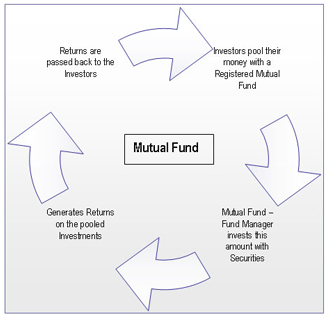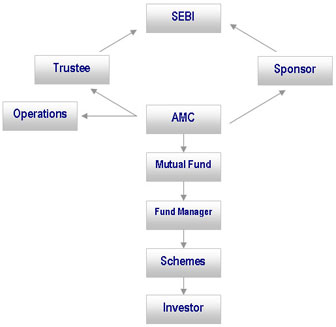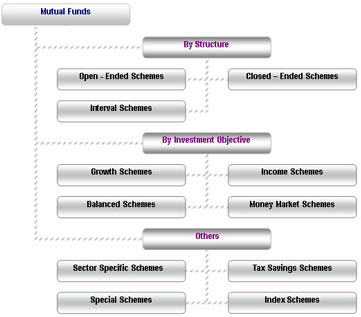|
|
|
MF Insight
|
|
|
|
What is a Mutual Fund
|
|
A Mutual Fund is a trust registered with the Securities and Exchange Board of India (SEBI), which pools up the money from individual / corporate investors and invests the same on behalf of the investors / unit holders, in equity shares, Government securities, Bonds, Call money markets etc., and distributes the profits. The income earned through these investments and the capital appreciation realised are shared by its unit holders in proportion to the number of units owned by them. This pooled income is professionally managed on behalf of the unit-holders, and each investor holds a proportion of the portfolio that is entitled not only to profits when the securities are sold, but also subject to any losses in value as well.
|
|
Why should I choose to Invest in Mutual Fund
|
For retail investor who does not have the time and expertise to analyze and invest in stocks and bonds, mutual funds offer a viable investment alternative. This is because:
Mutual Funds provide the benefit of cheap access to expensive stocks.
Mutual funds diversify the risk of the investor by investing in a basket of assets.
A team of professional fund managers manages them with in-depth research inputs from investment analysts.
o Being institutions with good bargaining power in markets, mutual funds have access to crucial corporate information which individual investors cannot access.
|
|
How Mutual Fund operates
|
|
The following chart gives us operational flow of a Mutual Fund
|

|
|
|
|
Entities Involved in Mutual Fund
|
|
The following diagram illustrates various entities involved in the organizational structure of a Mutual Fund
|

|
|
Advantages
|
|
Affordability
Professional management
Diversification
Variety of investment options according to the financial status of the investor
Return potential
Flexibility
Transparency
Tax benefits
Liquidity
Clear-cut regulations (SEBI)
|
|
No Control over Costs
|
|
Investor has to pay investment management fees as long as he remains in the fund |
|
No Tailor-made portfolios
|
|
Investors who invest on their own can build their own portfolios of shares, bonds and other securities. Investing through funds means he delegates this decision to fund managers
|
|
Managing portfolio of funds
|
|
Availability of large number of funds can actually mean too much of choice for the investor. He may again need advice on how to select a fund to achieve his objectives.
|
|
|

|
|
What are open-ended and closed-ended mutual funds?
|
|
In an open-ended mutual fund there are no limits on the total size of the corpus. Investors are permitted to enter and exit the open-ended mutual fund at any point of time at a price that is linked to the net asset value (NAV). In case of closed-ended funds, the total size of the corpus is limited by the size of the initial offer.
|
|
Do both open-ended and closed-ended funds come out with an initial offering?
|
|
Yes. But the only difference is that in case of open-ended funds, a month after the initial offer closes the continuous offer period starts when the investor can enter and exit the fund at a price linked to the NAV
|
|
o Unit Trust of India is the first mutual fund set up under a separate act, UTI Act in 1963, and started its operations in 1964 with the issue of units under the scheme US-64.
o In 1987 public sector banks like State Bank of India, Punjab National Bank, Indian Bank, Bank of India, and Bank of Baroda set up mutual funds.
o Apart from these above mentioned banks, Life Insurance Corporation (LIC) and General Insurance Corporation (GIC) too have set up mutual funds.
o With the entry of private sector funds, a new era started in the mutual fund industry (Examples include Reliance Mutual Fund, Deutsche Mutual Fund, ICICI Mutual Fund, HDFC Mutual Fund etc.,)
|
|
Which are the other institutions that have floated mutual funds in India?
|
|
Currently public sector banks like SBI, Canara Bank, ICICI, HDFC, institutions like IDBI and LIC foreign institutions like Alliance, Morgan Stanley, Templeton and private financial companies like Kothari Pioneer, DSP Merrill Lynch, Sundaram, Kotak Mahindra etc., have floated their own mutual funds.
|
|
How many Mutual Funds are there in India currently?
|
|
Presently there are 38 mutual funds in India and close to 400 mutual fund schemes.
|
|
Why has the concept of mutual funds taken so long to pick up in India?
|
|
Even in the US the concept of mutual funds has started picking up only in the last decade. This whole process of investor education and investor awareness takes a lot of time. But Indian investors are now beginning to understand the benefits of investing through the mutual funds route and hence the collections are beginning to pick up
|
|
What is the total size of the mutual fund sector in India?
|
|
Currently the total funds under mutual fund management in India are a little over Rs. 2,65,805 crore as on June 2006. Out of this UTI accounts for nearly 70 per cent while private funds account for around 22 per cent. The balance 8 per cent is managed by mutual funds floated by public sector banks and financial institutions
|
|
What is the Regulatory Body for Mutual Funds?
|
|
Securities Exchange Board of India (SEBI) is the regulatory body for all the mutual funds mentioned above. All the mutual funds must get registered with SEBI. The only exception is the UTI, since it is a corporation formed under a separate Act of Parliament.
|
|
How do mutual funds diversify their risks?
|
|
Financial theory states that an investor can reduce his total risk by holding a portfolio of assets instead of only one asset. This is because by holding all your money in just one asset, the entire fortunes of your portfolio depend on this one asset. By creating a portfolio of a variety of assets, this risk is substantially reduced.
|
|
Can mutual funds be viewed as risk-free investments?
|
|
No. Mutual fund investments are not totally risk free. In fact, investing in mutual funds contains the same risk as investing in the markets, the only difference being that due to professional management of funds the controllable risks are substantially reduced.
|
|
What are the risks involved in investing in mutual funds?
|
|
A very important risk involved in mutual fund investments is the market risk. When the market is in doldrums, most of the equity funds will also experience a downturn. However, the company specific risks are largely eliminated due to professional fund management.
|
|
How much return can I expect by investing in mutual funds?
|
|
Investors need to be clear that mutual funds are essentially medium to long term investments. Hence, short-term abnormal profits will not be sustainable in the long run. But in the medium to long run the mutual funds tend to outperform most other avenues of investments at the same time avoiding the risk of direct investment accompanied with professional fund management
|
|
What is the difference between mutual funds and portfolio management schemes?
|
|
While the concept remains the same of collecting money from investors, pooling them
and investing the funds, the target investors are different. In the case of portfolio
management the target investors are high networth investors while in case of mutual
funds the target investors are the retail investors
|
|
What are the broad guidelines issued for a Mutual Fund?
|
Mutual fund should be formed as a Trust under Indian Trust Act and should be operated by Asset Management Companies (AMCs).
Mutual fund needs to set up a Board of Trustees and Trustee Companies. They should also have their Board of Directors.
AMCs and Trustees of a mutual fund should be two separate and distinct legal entities.
The AMC or any of its companies cannot act as managers for any other fund.
AMCs have to get the approval of SEBI for its articles and memorandum of association
Mutual funds should distribute a minimum of 90% of their profits among the investors.
|
|
|